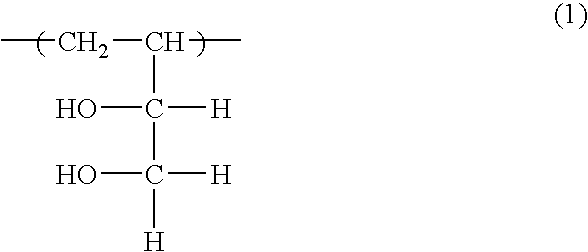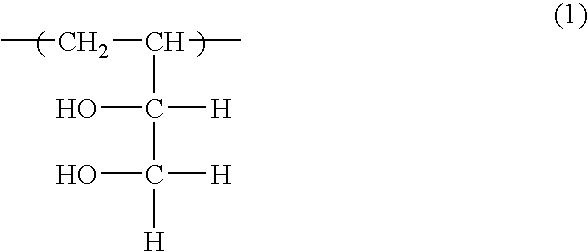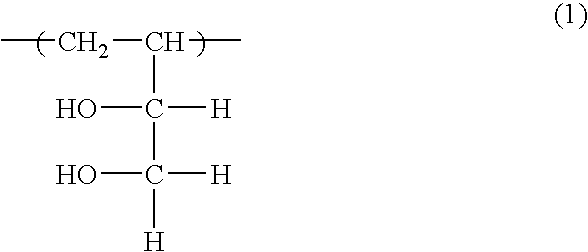Polyvinyl alcohol resin composition and films
a polyvinyl alcohol resin and composition technology, applied in the direction of film/foil adhesives, synthetic resin layered products, transportation and packaging, etc., can solve the problems of difficult to produce a product directly from the pva resin by a melt-forming method, product melt-formed from the resin composition suffers from fish eyes and gelation, and needs improvement. , to achieve the effect of high interlayer adhesive strength and excellent melt-formability
- Summary
- Abstract
- Description
- Claims
- Application Information
AI Technical Summary
Benefits of technology
Problems solved by technology
Method used
Image
Examples
example 1
Preparation of PVA Resin Composition
[0104]First, 95 parts by weight of the PVA resin (A1) prepared as the PVA resin (A) and 5 parts by weight of a compound (GLPM-60 available from Nippon Nyukazai Co., Ltd.) prepared as the alkylene oxide adduct (B) of the polyvalent alcohol through a reaction between 1 mole of glycerol and 6 moles of ethylene oxide were blended (in a weight ratio (A) / (B) of 95 / 5), and the resulting mixture was melted and extruded at a resin temperature of 190° C. and pelletized under the following conditions. Extruder: Twin screw extruder (15 mmφ, L / D=60) having full flight screws (CR=3.12), and provided with a vacuum vent, a cooling belt and a pelletizer[0105]Temperature pattern: C1 / C2 / C3 / C4 / C5 / C6 / C7 / C8 / D=90 / 120 / 150 / 170 / 180 / 180 / 190 / 190 / 190° C.
(wherein C1 to C8 indicate kneading portions of the extruder arranged in this order from a hopper side, and D indicates a dice portion)[0106]Screen mesh: 90 / 90[0107]Screw rotation speed: 250 rpm
[0108]Thus, a PVA resin composit...
examples 2 and 3
, and Comparative Examples 1 to 5
[0118]Multilayer films were produced and evaluated in substantially the same manner as in Example 1, except that PVA resins (A) and adducts (B) shown in Table 1 were blended in weight ratios shown in Table 1.
[0119]
TABLE 1PVA resin (A)Adduct (B)ModificationPolymerizationSaponificationPolyvalentHydroxyl valuedegree (mol %)degreedegree (mol %)alcoholAlkylene oxide(mg KOH / g)(A) / (B)Example 1830095.5GlycerolEthylene oxide47195 / 56 molesExample 2330089.5GlycerolEthylene oxide47195 / 56 molesExample 34.550088GlycerolEthylene oxide34590 / 109 molesComparative650098.6GlycerolEthylene oxide47195 / 5Example 16 molesComparative4.550098.6GlycerolEthylene oxide34590 / 10Example 29 molesComparative850098.6GlycerolEthylene oxide62895 / 5Example 32 molesComparative650078GlycerolEthylene oxide47195 / 5Example 46 molesComparative4.550088GlycerolEthylene oxide93590 / 10Example 52 moles
[0120]
TABLE 2Adhesive strength (N)OdorMFRMelting pointTransparencyLong-run formabilityImmediatelyAfter...
PUM
| Property | Measurement | Unit |
|---|---|---|
| mol % | aaaaa | aaaaa |
| carbon number | aaaaa | aaaaa |
| melt flow rate | aaaaa | aaaaa |
Abstract
Description
Claims
Application Information
 Login to View More
Login to View More - R&D
- Intellectual Property
- Life Sciences
- Materials
- Tech Scout
- Unparalleled Data Quality
- Higher Quality Content
- 60% Fewer Hallucinations
Browse by: Latest US Patents, China's latest patents, Technical Efficacy Thesaurus, Application Domain, Technology Topic, Popular Technical Reports.
© 2025 PatSnap. All rights reserved.Legal|Privacy policy|Modern Slavery Act Transparency Statement|Sitemap|About US| Contact US: help@patsnap.com



